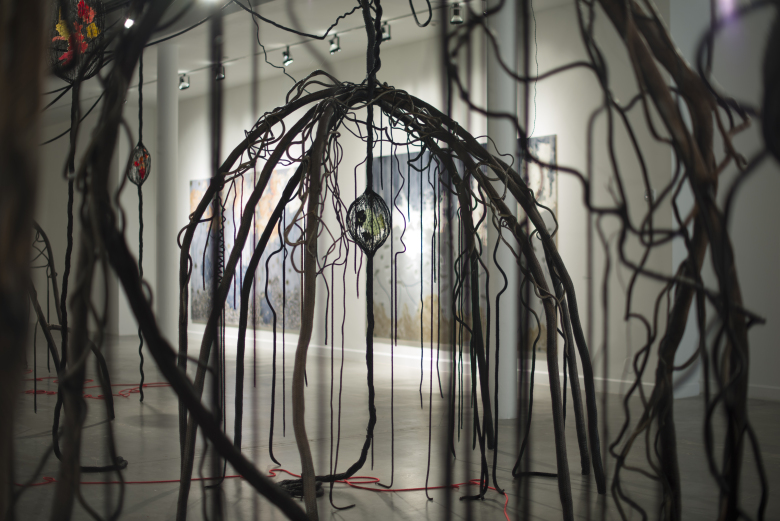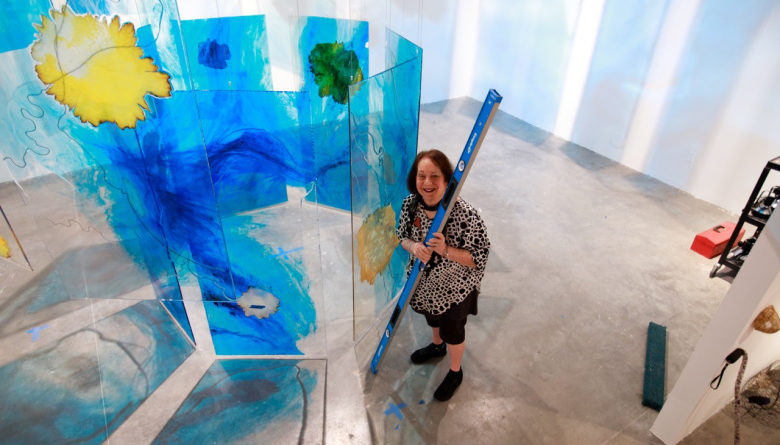INTERVIEW: Mira Lehr offers artistic response to climate armageddon in new exhibition
Photo: Mira Lehr is remembering 50 years of environmental art with her new exhibition High Water Mark at the Mennello Museum of American Art. Photo courtesy of the artist / Provided by News Travels Fast with permission.
Mira Lehr is on a mission. The Florida-based artist has been responding to the planet’s environmental degradation of the past 50 years with thoughtful pieces of work, and now her oeuvre will be on full display at Orlando’s Mennello Museum of American Art. The new exhibition, titled High Water Mark, compiles recent works with pieces that date back to 1969, when Lehr was selected to work with architect Buckminster Fuller for a watershed project on the environment.
High Water Mark runs at the Florida museum through May 10, and the exhibition marks the artist’s 50-year dedication to fighting for environmental awareness and using her skills to place a spotlight on climate change and rising sea levels.
“I feel that people fall in love with the environment,” Lehr said in a recent phone interview. “If they see the beauty of it, they’ll care for it more. I think that the time we’re in now is a very strange and very dangerous time because I don’t think people are aware, as they should be, of what’s going on in the environment, so therefore instead of doing work with verbal imagery and preaching to people, I feel if I make the work something they can relate to, I can tell them the story of how important it is to save what we have. And because it’s beautiful in a way that is strong, I think they’ll relate to the issues we face.”
Lehr knows about climate change not only because of her studies and explorations over the years, but also because she lives on the frontlines of the earthly conflict. She is based in Miami, which faces a perilous future if the winds of change don’t halt global warming. She is aware that her life and the life of her city’s residents have already been impacted by the global phenomenon.
“We’re one of the places that will be hit first, and it’s very dramatic,” Lehr said. “I live on the water, and I see that water changing. So it brings it right home to me. It’s nothing abstract. It’s right there in front of me, and, you know, we have these invasive species here now. Everything seems to happen so colorfully and so very graphically in Miami that it’s upon you, and you’re right in the middle of it.”
Because of the urgency that can be found in her works, Lehr actually prefers to use climate armageddon rather than climate change or global warming.
“It certainly calls attention to the immediacy of it, so I like that [term],” she said. “It’s been used so much, the other terms, that I’m afraid people might fall asleep and not realize it’s upon us, and that’s why I like the new term.”
In the early days, before she was tasked with working with Fuller’s group in the 1960s, she was not completely focused on these issues because some of them were not in the mainstream. It took some time, but she was convinced that these scientific realities needed to be addressed.
“I love nature,” Lehr said. “I always worked with nature, but I was not attuned to how our planet should be managed. I was not attuned to thinking of our planet as a spaceship. I had the feeling there’s plenty to go around for everyone. It’s endless; we’ll never reach any kind of crisis in agriculture or in land. There was no idea that the oceans would get poisoned then. It was definitely things would go on as usual forever. Then when I worked with [Fuller], I realized we’re a closed system. We have our spaceship Earth, and that’s what we have. And we have to watch it, or else. And we have to make it work for everyone, or it will work for no one. And so that’s why the project I did with him was called the World Game because it was the opposite of a war game where one side loses and one side loses. In the world game, everybody wins. I wanted all humanity to be winners.”
Fuller’s projects members investigated different topics and how they related to nature and the environment. Lehr was employed to look into the food chain and what humankind needs to be strong and have the right metabolic necessities.
“So we each worked on our own projects, but ultimately we all got together,” she said. “We realized that everything was based on energy, so that’s how it all came to a pointed reference to what needed to be done now. This is 1969, and it was that we needed to get off fossil fuels that were going to be poisoning our atmosphere. And we realized, like in Los Angeles when the cars weren’t busy on the weekend or something, the smog went way down, so we realized that fossil fuels were bad for the Earth. And we looked for new kinds of energy, and that was the beginning. And that continues now, and we’re now just addressing that we’re going to try to get off of fossil fuels.”

High Water Mark features pieces from this 1969 exploration into the food chain, fossil fuels and energy. Other pieces are more recent. “Invisible Cities,” for example, is a series of brass-formed nettings that cluster along the gallery’s walls, according to press notes. Inside the nets are names of extinct species. “Mixing Currents” is a gargantuan piece that takes up an entire gallery and features video projections and hanging light bulbs. This piece is meant to address the necessary nurturing of oceans and coral reefs, according to a press release.
“Some of the pieces were done as a result of Buckminster Fuller’s project, so that goes back some years,” Lehr said. “Many of them are brand new. The ‘Mangroves’ of the ropes, they’re new. They’re being configured for the Mennello. … It’s the same material of marine ropes and steel, but it’s being configured for the museum as site specific.”
These “Mangroves,” which almost look like forlorn spiders that have captured precious stones in their tangled webs, will surely be a highlight of the exhibition. The interactive work presents the climate armageddon not as a piece of visual art to appreciate on a wall, but as an all-encompassing sculpture that requires the public’s input.
“You’re supposed to go under them and around them,” Lehr said. “They’re above you. They’re on the walls. They’re on the ceilings, and they’ll travel through the galleries.”
In other words, one cannot get away from the “Mangroves,” an appropriate feature that mimics the devastating impact of the changing climate.
By John Soltes / Publisher / John@HollywoodSoapbox.com
High Water Mark, featuring the work of Mira Lehr, is on display through May 10 at the Mennello Museum of American Art in Orlando. Click here for more information and tickets.

